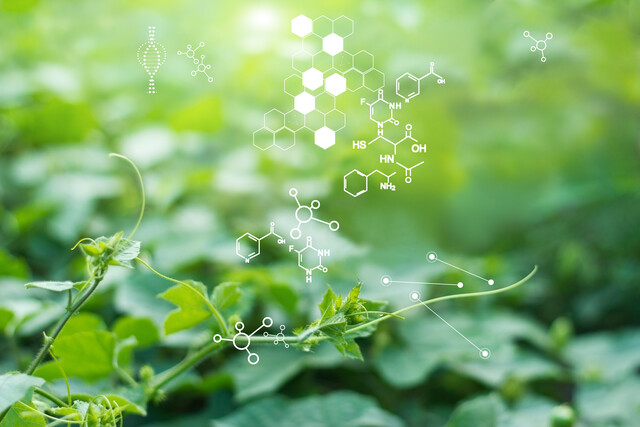Online Class: Organic Chemistry 101
We're sorry, this course is no longer open for enrollment.
-
25Lessons
-
48Exams &
Assignments -
25Hours
average time -
2.5CEUs
Course Description
Organic chemistry is a branch of general chemistry that focuses on carbon-based compounds. Starting with the simplest molecules, alkanes (carbon chains bound to hydrogen atoms), the course expands to examine more complex molecules, including their basic properties, how they can be synthesized, and how they interact with other molecules.
This highly qualitative course begins by laying a foundation in quantum theory, which describes how atoms interact to form bonds and, thus, molecules. In addition to considering at chemical interactions, the course also takes a brief look at stereochemistry (the arrangement of molecules in three dimensions) and spectroscopy (using light to determine the composition of materials). The course culminates with a brief look at some elements of biochemistry, which examines the behavior of chemicals in biological systems (organisms). Emphases throughout the course include IUPAC nomenclature for organic molecules, the behavior and properties of chemicals with a variety of functional groups, and conceptual methods of synthesizing different organic compounds.
Although the course is not nearly an exhaustive examination of this highly complex subject, it provides a solid foundation for students who simply want to learn more about the subject or who want to review the material in preparation for an introductory or more advanced course in high school or college. Because the course is qualitative rather than quantitative, students do not require extensive math skills to complete the course successfully. Nevertheless, the course provides a solid conceptual understanding for those who wish to study elsewhere the quantitative aspects of the topic.
Course Lessons
Lesson 1. Chemical Bonding Basics: A Dive into Organic Chemistry
 Review Practice Worksheet: Lesson-1-WordSearch-11732.pdf
Review Practice Worksheet: Lesson-1-WordSearch-11732.pdf Lesson discussions: Reasons for Taking this Course
Lesson discussions: Reasons for Taking this Course Complete: Lesson 1 Assignment
Complete: Lesson 1 Assignment  Assessment: Lesson 1 Bonding and Molecular Structure I: Chemical Bonding
Assessment: Lesson 1 Bonding and Molecular Structure I: Chemical Bonding
Lesson 2. The Art of Drawing Organic Molecules
 Review Practice Worksheet: Lesson-2-HomeWork-11733.pdf
Review Practice Worksheet: Lesson-2-HomeWork-11733.pdf Complete: Lesson 2 Assignment
Complete: Lesson 2 Assignment Assessment: Lesson 2 Bonding and Molecular Structure II: The Structure and Representation of Organic Molecules
Assessment: Lesson 2 Bonding and Molecular Structure II: The Structure and Representation of Organic Molecules
Lesson 3. The Fundamentals of Acids and Bases: A Comprehensive Exploration
 Review Practice Worksheet: Lesson-3-Downloadable-11734.pdf
Review Practice Worksheet: Lesson-3-Downloadable-11734.pdf Complete: Lesson 3 Assignment
Complete: Lesson 3 Assignment Assessment: Lesson 3 Acids and Bases
Assessment: Lesson 3 Acids and Bases
Lesson 4. Mastering IUPAC Nomenclature for Basic Organic Molecules
 Review Practice Worksheet: Lesson-4-Activity-11735.pdf
Review Practice Worksheet: Lesson-4-Activity-11735.pdf Complete: Lesson 4 Assignment
Complete: Lesson 4 Assignment Assessment: Lesson 4 Alkanes and Cycloalkanes I: Nomenclature
Assessment: Lesson 4 Alkanes and Cycloalkanes I: Nomenclature
Lesson 5. Intramolecular Mechanics of Alkanes and Cycloalkanes
 Review Practice Worksheet: Lesson-5-HomeWork-11736.pdf
Review Practice Worksheet: Lesson-5-HomeWork-11736.pdf Complete: Lesson 5 Assignment
Complete: Lesson 5 Assignment Assessment: Lesson 5 Alkanes and Cycloalkanes II: Bonding, Intermolecular Forces, and Functional Groups
Assessment: Lesson 5 Alkanes and Cycloalkanes II: Bonding, Intermolecular Forces, and Functional Groups
Lesson 6. The Essentials: Naming Alkyl Halides, Alcohols, Alkenes, Alkynes
 Review Practice Worksheet: Lesson-6-HomeWork-11737.pdf
Review Practice Worksheet: Lesson-6-HomeWork-11737.pdf Complete: Lesson 6 Assignment
Complete: Lesson 6 Assignment Assessment: Lesson 6 Nomenclature for Alkyl Halides, Alcohols, Alkenes, and Alkynes
Assessment: Lesson 6 Nomenclature for Alkyl Halides, Alcohols, Alkenes, and Alkynes
Lesson 7. The Role of Hybrid Orbitals in Double and Triple Bonds
 Review Practice Worksheet: Lesson-7-Downloadable-11738.pdf
Review Practice Worksheet: Lesson-7-Downloadable-11738.pdf Complete: Lesson 7 Assignment
Complete: Lesson 7 Assignment Assessment: Lesson 7 Alkenes/Alkynes I: Properties and Synthesis
Assessment: Lesson 7 Alkenes/Alkynes I: Properties and Synthesis
Lesson 8. Addition Reactions: Beyond Carbon-Carbon Double Bonds
 Review Practice Worksheet: Lesson-8-WordSearch-11739.pdf
Review Practice Worksheet: Lesson-8-WordSearch-11739.pdf Complete: Lesson 8 Assignment
Complete: Lesson 8 Assignment Assessment: Lesson 8 Alkenes and Alkynes II: Addition Reactions
Assessment: Lesson 8 Alkenes and Alkynes II: Addition Reactions
Lesson 9. Nucleophilic Substitution Reactions Simplified
 Review Practice Worksheet: Lesson-9-Downloadable-11740.pdf
Review Practice Worksheet: Lesson-9-Downloadable-11740.pdf Complete: Lesson 9 Assignment
Complete: Lesson 9 Assignment Assessment: Lesson 9 Nucleophilic Substitution of Alkyl Halides
Assessment: Lesson 9 Nucleophilic Substitution of Alkyl Halides
Lesson 10. Understanding the Handedness of Molecules
 Review Practice Worksheet: Lesson-10-WordSearch-11741.pdf
Review Practice Worksheet: Lesson-10-WordSearch-11741.pdf Complete: Lesson 10 Assignment
Complete: Lesson 10 Assignment Assessment: Lesson 10 Stereochemistry
Assessment: Lesson 10 Stereochemistry
Lesson 11. Free Radicals and Their Role in Polymerization
 Review Practice Worksheet: Lesson-11-WordSearch-11742.pdf
Review Practice Worksheet: Lesson-11-WordSearch-11742.pdf Complete: Lesson 11 Assignment
Complete: Lesson 11 Assignment
Lesson 12. Benzene: The Quintessential Arene
 Review Practice Worksheet: Lesson-12-WorkSheet-11743.pdf
Review Practice Worksheet: Lesson-12-WorkSheet-11743.pdf Complete: Lesson 12 Assignment
Complete: Lesson 12 Assignment
Lesson 13. Exploring the Reactions of Aromatic Compounds: An In-depth Guide to Electrophilic Substitution and Birch Reduction
 Review Practice Worksheet: Lesson-13-WordSearch-11744.pdf
Review Practice Worksheet: Lesson-13-WordSearch-11744.pdf Complete: Lesson 13 Assignment
Complete: Lesson 13 Assignment Assessment: Lesson 13 Reactions of Aromatic Compounds
Assessment: Lesson 13 Reactions of Aromatic Compounds
Lesson 14. Introduction to Spectroscopy Techniques: NMR, Mass Spectrometry, and IR
 Review Practice Worksheet: Lesson-14-HomeWork-11745.pdf
Review Practice Worksheet: Lesson-14-HomeWork-11745.pdf Complete: Lesson 14 Assignment
Complete: Lesson 14 Assignment Assessment: Lesson 14 NMR, Mass Spectrometry, and Infrared (IR) Spectroscopy
Assessment: Lesson 14 NMR, Mass Spectrometry, and Infrared (IR) Spectroscopy
Lesson 15. The Alchemy of Alcohols: Synthesis and Beyond
 Review Practice Worksheet: Lesson-15-WordSearch-11746.pdf
Review Practice Worksheet: Lesson-15-WordSearch-11746.pdf Complete: Lesson 15 Assignment
Complete: Lesson 15 Assignment Assessment: Lesson 15 Synthesis and Reactions of Alcohols
Assessment: Lesson 15 Synthesis and Reactions of Alcohols
Lesson 16. Ethers & Epoxides Decoded
 Review Practice Worksheet: Lesson-16-HomeWork-11747.pdf
Review Practice Worksheet: Lesson-16-HomeWork-11747.pdf Complete: Lesson 16 Assignment
Complete: Lesson 16 Assignment Assessment: Lesson 16 Ethers and Epoxides
Assessment: Lesson 16 Ethers and Epoxides
Lesson 17. The Role of Nucleophilic Addition in Carbonyl Chemistry
 Review Practice Worksheet: Lesson-17-WordSearch-11748.pdf
Review Practice Worksheet: Lesson-17-WordSearch-11748.pdf Complete: Lesson 17 Assignment
Complete: Lesson 17 Assignment Assessment: Lesson 17 - Aldehydes and Ketones 1: Introduction and Nucleophilic Addition to Carbonyl Group
Assessment: Lesson 17 - Aldehydes and Ketones 1: Introduction and Nucleophilic Addition to Carbonyl Group
Lesson 18. The Chemistry of Enols, Enolates, and their Aldehyde and Ketone Counterparts
 Review Practice Worksheet: Lesson-18-WordSearch-11749.pdf
Review Practice Worksheet: Lesson-18-WordSearch-11749.pdf Complete: Lesson 18 Assignment
Complete: Lesson 18 Assignment Assessment: Lesson 18 - Aldehydes and Ketones 2: Enols and Enolates
Assessment: Lesson 18 - Aldehydes and Ketones 2: Enols and Enolates
Lesson 19. Diene Dynamics: Understanding Conjugated Systems
 Review Practice Worksheet: Lesson-19-Downloadable-11750.pdf
Review Practice Worksheet: Lesson-19-Downloadable-11750.pdf Complete: Lesson 19 Assignment
Complete: Lesson 19 Assignment Assessment: Lesson 19 - Conjugated Unsaturated Systems
Assessment: Lesson 19 - Conjugated Unsaturated Systems
Lesson 20. Exploring the Chemistry of ?-Dicarbonyls: Synthesis and Reactions Explained
 Review Practice Worksheet: Lesson-20-Activity-11751.pdf
Review Practice Worksheet: Lesson-20-Activity-11751.pdf Complete: Lesson 20 Assignment
Complete: Lesson 20 Assignment Assessment: Lesson 20 - Synthesis and Reactions of β-Bicarbonyl Compounds
Assessment: Lesson 20 - Synthesis and Reactions of β-Bicarbonyl Compounds
Lesson 21. Exploring the World of Carboxylic Acids and Their Fascinating Derivatives
 Review Practice Worksheet: Lesson-21-Downloadable-11752.pdf
Review Practice Worksheet: Lesson-21-Downloadable-11752.pdf Complete: Lesson 21 Assignment
Complete: Lesson 21 Assignment Assessment: Lesson 21 - Carboxylic Acids and Derivatives
Assessment: Lesson 21 - Carboxylic Acids and Derivatives
Lesson 22. Amines: A Basic Introduction
 Review Practice Worksheet: Lesson-22-HomeWork-11753.pdf
Review Practice Worksheet: Lesson-22-HomeWork-11753.pdf Complete: Lesson 22 Assignment
Complete: Lesson 22 Assignment Assessment: Lesson 22 - Amines
Assessment: Lesson 22 - Amines
Lesson 23. Delving Into Aromatic Substitutions: From Aniline to Aryl Halides
 Review Practice Worksheet: Lesson-23-HomeWork-11754.pdf
Review Practice Worksheet: Lesson-23-HomeWork-11754.pdf Complete: Lesson 23 Assignment
Complete: Lesson 23 Assignment Assessment: Lesson 23 - Phenols and Aryl Halides
Assessment: Lesson 23 - Phenols and Aryl Halides
Lesson 24. Carbohydrates: An Overview
 Review Practice Worksheet: Lesson-24-HomeWork-11755.pdf
Review Practice Worksheet: Lesson-24-HomeWork-11755.pdf Complete: Lesson 24 Assignment
Complete: Lesson 24 Assignment Assessment: Lesson 24 - Carbohydrates
Assessment: Lesson 24 - Carbohydrates
Lesson 25. Exploring Lipids: A Gateway to Biochemistry
 Review Practice Worksheet: Lesson-25-Activity-11756.pdf
Review Practice Worksheet: Lesson-25-Activity-11756.pdf Lesson discussions: What do you think about this course?; Program Evaluation Follow-up Survey (End of Course); Course Comments; Course Comments
Lesson discussions: What do you think about this course?; Program Evaluation Follow-up Survey (End of Course); Course Comments; Course Comments Assessment: Lesson 25 - Lipids
Assessment: Lesson 25 - Lipids Assessment: The Final Exam
Assessment: The Final Exam
Learning Outcomes
- Recognize ionic and covalent bonds between atoms and some of their basic characteristics
- Use Lewis structures to represent molecules and explain the octet rule in the context of chemical bonding
- Apply the VSEPR model to predict and sketch the three-dimensional configuration of a simple organic molecule, assessing bond angles and molecular geometry.
- Demonstrate the ability to draw simplified structural formulas for organic molecules, accurately representing the arrangement and connectivity of atoms and bonds.
- Evaluate the strength of acids and bases by analyzing bond strength and electronegativity factors.
- Recognize and classify acids and bases using the Arrhenius, Brønsted-Lowry, and Lewis models.
- Apply the IUPAC naming convention to correctly identify and name cycloalkanes, based on their structural substituents.
- Define the IUPAC nomenclature rules to systematically name alkanes and identify distinct isomers.
- Recognize and classify sigma (?) bonds and apply knowledge of van der Waals forces to predict boiling points of alkanes.
- Understand the concept of orbital hybridization and its role in forming sp³ hybrid orbitals in carbon structures.
- Apply IUPAC rules to accurately name organic compounds containing alkyl halides, alcohols, alkenes, and alkynes using functional class and substitutive nomenclature.
- Recognize and identify the presence of functional groups (alkyl halides, alcohols, alkenes, and alkynes) in organic compounds using IUPAC nomenclature.
- Define the process of orbital hybridization in the formation of sp2 and sp hybrid orbitals and apply this understanding to predict the structural geometry of alkenes and alkynes.
- Demonstrate mastery of lesson content at levels of 70% or higher.
Student Testimonials
- "The instructor has been wonderful and knowledgeable in every course I've taken with her. I have appreciated her help in the subject matter, and wish her the best." -- Ian B.
Related Courses
-
 5 hours
0.5 CEUs
Business Coaching
+ More Info
5 hours
0.5 CEUs
Business Coaching
+ More Info
-
 19 hours
1.9 CEUs
Creative Writing 101
+ More Info
19 hours
1.9 CEUs
Creative Writing 101
+ More Info
-
 3 hours
0.3 CEUs
Egyptian Mythology 101
+ More Info
3 hours
0.3 CEUs
Egyptian Mythology 101
+ More Info
-
 4 hours
0.4 CEUs
Norse Mythology 101
+ More Info
4 hours
0.4 CEUs
Norse Mythology 101
+ More Info
-
 5 hours
0.5 CEUs
Kaizen 101 - An Introduction
+ More Info
5 hours
0.5 CEUs
Kaizen 101 - An Introduction
+ More Info
-
 5 hours
0.5 CEUs
Positive Parenting Techniques
+ More Info
5 hours
0.5 CEUs
Positive Parenting Techniques
+ More Info
-
 4 hours
0.4 CEUs
Chakras Level 1
+ More Info
4 hours
0.4 CEUs
Chakras Level 1
+ More Info
-
 5 hours
0.5 CEUs
Critical Thinking Skills
+ More Info
5 hours
0.5 CEUs
Critical Thinking Skills
+ More Info
-
 10 hours
1.0 CEUs
ESL Grammar Skills Level 3
+ More Info
10 hours
1.0 CEUs
ESL Grammar Skills Level 3
+ More Info
-
 3 hours
0.3 CEUs
HR Compensation and Benefits
+ More Info
3 hours
0.3 CEUs
HR Compensation and Benefits
+ More Info
-
 12 hours
1.2 CEUs
How to Write Case Studies
+ More Info
12 hours
1.2 CEUs
How to Write Case Studies
+ More Info
-
 11 hours
1.1 CEUs
Proofreading and Copyediting 101
+ More Info
11 hours
1.1 CEUs
Proofreading and Copyediting 101
+ More Info



